Patterns and Drivers of Surface Energy Flux in the Alpine Meadow Ecosystem in the Qilian Mountains, Northwest China
Abstract
1. Introduction
2. Results
2.1. The Environmental Variables
2.2. Daily Variations in the Characteristics of Energy
2.3. Seasonal Distribution and Proportional Characteristics of Energy Fluxes
2.4. Factors Influencing Energy Fluxes
3. Discussion
3.1. Seasonal Variations in Energy Components
3.2. Factors Influencing Energy Fluxes in Alpine Meadow Ecosystems
4. Materials and Methods
4.1. Study Site
4.2. Instruments and Measurements
4.3. Bowen Ratio Energy Balance (BREB) Method
4.4. Exclusion of Outliers and Imputation
4.5. Energy Closure Calculation
4.6. Data Analysis
5. Conclusions
Author Contributions
Funding
Data Availability Statement
Conflicts of Interest
References
- Qu, S.; Xu, R.; Yu, J.; Li, F.; Wei, D.; Borjigidai, A. Nitrogen deposition accelerates greenhouse gas emissions at an alpine steppe site on the Tibetan Plateau. Sci. Total Environ. 2021, 765, 144277. [Google Scholar] [CrossRef] [PubMed]
- Si, M.; Guo, X.; Lan, Y.; Fan, B.; Cao, G. Effects of Climatic Variability on Soil Water Content in an Alpine Kobresia Meadow, Northern Qinghai–Tibetan Plateau, China. Water 2022, 14, 2754. [Google Scholar] [CrossRef]
- Aires, L.M.; Pio, C.A.; Pereira, J.S. The effect of drought on energy and water vapour exchange above a mediterranean C3/C4 grassland in Southern Portugal. Agric. For. Meteorol. 2008, 148, 565–579. [Google Scholar] [CrossRef]
- Gao, Y.; Zhao, C.; Rong, Z.; Liu, J.; Wang, Q.; Ge, L.; Guo, Z.; Mao, Y. Energy exchange between the atmosphere and a subalpine meadow in the Qilian Mountains, northwest China. J. Hydrol. 2019, 572, 771–780. [Google Scholar]
- Iziomon, M.G.; Mayer, H. On the variability and modelling of surface albedo and long-wave radiation components. Agric. For. Meteorol. 2002, 111, 141–152. [Google Scholar] [CrossRef]
- Wang, Y.; You, C.; Gao, Y.; Li, Y.; Niu, Y.; Shao, C.; Wang, X.; Xin, X.; Yu, G.; Han, X.; et al. Seasonal variations and drivers of energy fluxes and partitioning along an aridity gradient in temperate grasslands of Northern China. Agric. For. Meteorol. 2023, 342, 109736. [Google Scholar] [CrossRef]
- Yue, P.; Zhang, Q.; Zhang, L.; Li, H.; Yang, Y.; Zeng, J.; Wang, S. Long-term variations in energy partitioning and evapotranspiration in a semiarid grassland in the Loess Plateau of China. Agric. For. Meteorol. 2019, 278, 323–336. [Google Scholar] [CrossRef]
- Zhang, K.; Liu, D.; Liu, H.; Lei, H.; Guo, F.; Xie, S.; Meng, X.; Huang, Q. Energy flux observation in a shrub ecosystem of a gully region of the Chinese Loess Plateau. Ecohydrol. Hydrobiol. 2022, 22, 323–336. [Google Scholar] [CrossRef]
- Liu, X.; Chen, B. Climatic warming in the Tibetan Plateau during recent decades. Int. J. Climatol. 2000, 20, 1729–1742. [Google Scholar] [CrossRef]
- Zhang, L.; Shen, M.; Yang, Z.; Wang, Y.; Chen, J. Spatial variations in the difference in elevational shifts between greenness and temperature isolines across the Tibetan Plateau grasslands under warming. Sci. Total Environ. 2024, 906, 167715. [Google Scholar] [CrossRef]
- Ma, Y.; Guan, Q.; Sun, Y.; Zhang, J.; Yang, L.; Yang, E.; Li, H.; Du, Q. Three-dimensional dynamic characteristics of vegetation and its response to climatic factors in the Qilian Mountains. Catena 2022, 208, 105694. [Google Scholar] [CrossRef]
- Qian, D.; Du, Y.; Li, Q.; Guo, X.; Fan, B.; Cao, G. Impacts of alpine shrub-meadow degradation on its ecosystem services and spatial patterns in Qinghai-Tibetan Plateau. Ecol. Indic. 2022, 135, 108541. [Google Scholar] [CrossRef]
- Wei, L.; Zhao, W.; Feng, X.; Han, C.; Li, T.; Qi, J.; Li, Y. Freeze-thaw desertification of alpine meadow in Qilian Mountains and the implications for alpine ecosystem management. Catena 2023, 232, 107471. [Google Scholar] [CrossRef]
- Zhang, L.; Chen, Z.; Zhang, X.; Zhao, L.; Li, Q.; Chen, D.; Tang, Y.; Gu, S. Evapotranspiration and Its Partitioning in Alpine Meadow of Three-River Source Region on the Qinghai-Tibetan Plateau. Water 2021, 13, 2061. [Google Scholar] [CrossRef]
- Chen, S.P.; Chen, J.Q.; Lin, G.H.; Zhang, W.L.; Miao, H.X.; Wei, L.; Huang, J.H.; Han, X.G. Energy balance and partition in Inner Mongolia steppe ecosystems with different land use types. Agric. For. Meteorol. 2009, 149, 1800–1809. [Google Scholar] [CrossRef]
- Ryu, Y.; Baldocchi, D.D.; Ma, S.; Hehn, T. Interannual variability of evapotranspiration and energy exchange over an annual grassland in California. J. Geophys. Res. Atmos. 2008, 113, D09104. [Google Scholar] [CrossRef]
- Yan, C.; Zhao, W.; Wang, Y.; Yang, Q.; Zhang, Q.; Qiu, G.Y. Effects of forest evapotranspiration on soil water budget and energy flux partitioning in a subalpine valley of China. Agric. For. Meteorol. 2017, 246, 207–217. [Google Scholar] [CrossRef]
- Chang, Y.P.; Ding, Y.J.; Zhang, S.Q.; Qin, J.; Zhao, Q.D. Dynamics and environmental controls of evapotranspiration for typical alpine meadow in the northeastern Tibetan Plateau. J. Hydrol. 2022, 612, 128282. [Google Scholar] [CrossRef]
- Gu, S.; Tang, Y.; Cui, X.; Kato, T.; Du, M.; Li, Y.; Zhao, X. Energy exchange between the atmosphere and a meadow ecosystem on the Qinghai–Tibetan Plateau. Agric. For. Meteorol. 2005, 129, 175–185. [Google Scholar] [CrossRef]
- Hu, Z.; Wang, G.; Sun, X.; Huang, K.; Song, C.; Li, Y.; Sun, S.; Sun, J.; Lin, S.; Zhang, Y. Energy partitioning and controlling factors of evapotranspiration in an alpine meadow in the permafrost region of the Qinghai-Tibet Plateau. J. Plant Ecol. 2024, 17, rtae002. [Google Scholar] [CrossRef]
- Li, J.; Jiang, S.; Wang, B.; Jiang, W.-W.; Tang, Y.-H.; Du, M.-Y.; Gu, S. Evapotranspiration and Its Energy Exchange in Alpine Meadow Ecosystem on the Qinghai-Tibetan Plateau. J. Integr. Agric. 2013, 12, 1396–1401. [Google Scholar] [CrossRef]
- Li, Y.; Sun, R.; Liu, S. Vegetation physiological parameter setting in the Simple Biosphere model 2 (SiB2) for alpine meadows in the upper reaches of Heihe river. Sci. China Earth Sci. 2014, 58, 755–769. [Google Scholar] [CrossRef]
- Shang, L.Y.; Zhang, Y.; Lü, S.H.; Wang, S.Y. Energy exchange of an alpine grassland on the eastern Qinghai-Tibetan Plateau. Sci. Bull. 2015, 60, 435–446. [Google Scholar] [CrossRef]
- Xie, J.; Yu, Y.; Li, J.-l.; Ge, J.; Liu, C. Comparison of surface sensible and latent heat fluxes over the Tibetan Plateau from reanalysis and observations. Meteorol. Atmos. Phys. 2018, 131, 567–584. [Google Scholar] [CrossRef]
- Yang, K.; Guo, X.; Wu, B. Recent trends in surface sensible heat flux on the Tibetan Plateau. Sci. China Earth Sci. 2010, 54, 19–28. [Google Scholar] [CrossRef]
- Ma, Y.; Fan, S.; Ishikawa, H.; Tsukamoto, O.; Yao, T.; Koike, T.; Zuo, H.; Hu, Z.; Su, Z. Diurnal and inter-monthly variation of land surface heat fluxes over the central Tibetan Plateau area. Theor. Appl. Climatol. 2004, 80, 259–273. [Google Scholar] [CrossRef]
- Wang, S.; Ma, Y.; Liu, Y. Simulation of sensible and latent heat fluxes on the Tibetan Plateau from 1981 to 2018. Atmos. Res. 2022, 271, 106129. [Google Scholar] [CrossRef]
- Xin, Y.-F.; Chen, F.; Zhao, P.; Barlage, M.; Blanken, P.; Chen, Y.-L.; Chen, B.; Wang, Y.-J. Surface energy balance closure at ten sites over the Tibetan plateau. Agric. For. Meteorol. 2018, 259, 317–328. [Google Scholar] [CrossRef]
- Yao, J.; Zhao, L.; Ding, Y.; Gu, L.; Jiao, K.; Qiao, Y.; Wang, Y. The surface energy budget and evapotranspiration in the Tanggula region on the Tibetan Plateau. Cold Reg. Sci. Technol. 2008, 52, 326–340. [Google Scholar] [CrossRef]
- Yao, J.M.; Zhao, L.; Gu, L.L.; Qiao, Y.P.; Jiao, K.Q. The surface energy budget in the permafrost region of the Tibetan Plateau. Atmos. Res. 2011, 102, 394–407. [Google Scholar] [CrossRef]
- Zhang, S.Y.; Li, X.Y.; Zhao, G.Q.; Huang, Y.M. Surface energy fluxes and controls of evapotranspiration in three alpine ecosystems of Qinghai Lake watershed, NE Qinghai-Tibet Plateau. Ecohydrology 2015, 9, 267–279. [Google Scholar] [CrossRef]
- Ma, Y.; Yao, T.; Zhong, L.; Wang, B.; Xu, X.; Hu, Z.; Ma, W.; Sun, F.; Han, C.; Li, M.; et al. Comprehensive study of energy and water exchange over the Tibetan Plateau: A review and perspective: From GAME/Tibet and CAMP/Tibet to TORP, TPEORP, and TPEITORP. Earth-Sci. Rev. 2023, 237, 104312. [Google Scholar] [CrossRef]
- Zhang, X.; Gu, S.; Zhao, X.; Cui, X.; Zhao, L.; Xu, S.; Du, M.; Jiang, S.; Gao, Y.; Ma, C.; et al. Radiation partitioning and its relation to environmental factors above a meadow ecosystem on the Qinghai-Tibetan Plateau. J. Geophys. Res. Atmos. 2010, 115, D10106. [Google Scholar] [CrossRef]
- Tanaka, K.; Ishikawa, H.; Hayashi, T.; Tamagawa, I.; Ma, Y. Surface Energy Budget at Amdo on the Tibetan Plateau using GAME/Tibet IOP98 Data. J. Meteorol. Soc. Jpn. Ser. II 2001, 79, 505–517. [Google Scholar] [CrossRef]
- Li, H.Q.; Zhang, F.W.; Zhu, J.B.; Guo, X.W.; Li, Y.K.; Lin, L.; Zhang, L.M.; Yang, Y.S.; Li, Y.N.; Cao, G.M.; et al. Precipitation rather than evapotranspiration determines the warm-season water supply in an alpine shrub and an alpine meadow. Agric. For. Meteorol. 2021, 300, 108318. [Google Scholar] [CrossRef]
- Liu, Z.; Chen, R.; Qi, J.; Dang, Z.; Han, C.; Yang, Y. Control of Mosses on Water Flux in an Alpine Shrub Site on the Qilian Mountains, Northwest China. Plants 2022, 11, 3111. [Google Scholar] [CrossRef]
- Lu, H.; Koike, T.; Yang, K.; Hu, Z.; Xu, X.; Rasmy, M.; Kuria, D.; Tamagawa, K. Improving land surface soil moisture and energy flux simulations over the Tibetan plateau by the assimilation of the microwave remote sensing data and the GCM output into a land surface model. Int. J. Appl. Earth Obs. Geoinf. 2012, 17, 43–54. [Google Scholar] [CrossRef]
- Byun, K.; Liaqat, U.W.; Choi, M. Dual-model approaches for evapotranspiration analyses over homo- and heterogeneous land surface conditions. Agric. For. Meteorol. 2014, 197, 169–187. [Google Scholar] [CrossRef]
- Escarabajal-Henarejos, D.; Fernández-Pacheco, D.G.; Molina-Martínez, J.M.; Martínez-Molina, L.; Ruiz-Canales, A. Selection of device to determine temperature gradients for estimating evapotranspiration using energy balance method. Agric. Water Manag. 2015, 151, 136–147. [Google Scholar] [CrossRef]
- Zhuang, Y.; Zhao, W. Dew formation and its variation in Haloxylon ammodendron plantations at the edge of a desert oasis, northwestern China. Agric. For. Meteorol. 2017, 247, 541–550. [Google Scholar] [CrossRef]
- Li, H.; Zhang, F.; Zhu, J.; Li, J.; Guo, X.; Zhou, H.; Li, Y. Surface Albedo Dominates Radiation Efficiency of Alpine Grasslands Along an Elevation Profile of Qilian Mountains. J. Geophys. Res. Atmos. 2024, 129, e2023JD040649. [Google Scholar] [CrossRef]
- Minderlein, S.; Menzel, L. Evapotranspiration and energy balance dynamics of a semi-arid mountainous steppe and shrubland site in Northern Mongolia. Environ. Earth Sci. 2014, 73, 593–609. [Google Scholar] [CrossRef]
- Wang, K.; Ma, N.; Zhang, Y.; Qiang, Y.; Guo, Y. Evapotranspiration and energy partitioning of a typical alpine wetland in the central Tibetan Plateau. Atmos. Res. 2022, 267, 105931. [Google Scholar] [CrossRef]
- Zhang, X.; Liu, X.; Zhang, L.; Chen, Z.; Zhao, L.; Li, Q.; Chen, D.; Gu, S.J.A.; Meteorology, F. Comparison of energy partitioning between artificial pasture and degraded meadow in three-river source region on the Qinghai-Tibetan Plateau: A case study. Environ. Earth Sci. 2019, 271, 251–263. [Google Scholar] [CrossRef]
- You, Q.G.; Xue, X.; Peng, F.; Dong, S.Y.; Gao, Y.H. Surface water and heat exchange comparison between alpine meadow and bare land in a permafrost region of the Tibetan Plateau. Agric. For. Meteorol. 2017, 232, 48–65. [Google Scholar] [CrossRef]
- Peng, F.; You, Q.; Xue, X.; Guo, J.; Wang, T.J.E.E. Evapotranspiration and its source components change under experimental warming in alpine meadow ecosystem on the Qinghai-Tibet plateau. Ecol. Eng. 2015, 84, 653–659. [Google Scholar] [CrossRef]
- Allen, R.G.; Trezza, R.; Tasumi, M. Analytical integrated functions for daily solar radiation on slopes. Agric. For. Meteorol. 2006, 139, 55–73. [Google Scholar] [CrossRef]
- Ma, Y.; Wang, Y.; Wu, R.; Hu, Z.; Yang, K.; Li, M.; Ma, W.; Zhong, L.; Sun, F.; Chen, X.; et al. Recent advances on the study of atmosphere-land interaction observations on the Tibetan Plateau. Hydrol. Earth Syst. Sci. 2009, 13, 1103–1111. [Google Scholar] [CrossRef]
- Tanaka, K.; Tamagawa, I.; Ishikawa, H.; Ma, Y.M.; Hu, Z.Y. Surface energy budget and closure of the eastern Tibetan Plateau during the GAME-Tibet IOP 1998. J. Hydrol. 2003, 283, 169–183. [Google Scholar] [CrossRef]
- Mu, Y.M.; Yuan, Y.; Jia, X.; Zha, T.S.; Qin, S.G.; Ye, Z.Q.; Liu, P.; Yang, R.Z.; Tian, Y. Hydrological losses and soil moisture carryover affected the relationship between evapotranspiration and rainfall in a temperate semiarid shrubland. Agric. For. Meteorol. 2022, 315, 108831. [Google Scholar] [CrossRef]
- Todd, R.W.; Evett, S.R.; Howell, T.A. The Bowen ratio-energy balance method for estimating latent heat flux of irrigated alfalfa evaluated in a semi-arid, advective environment. Agric. For. Meteorol. 2000, 103, 335–348. [Google Scholar] [CrossRef]
- Forzieri, G.; Miralles, D.G.; Ciais, P.; Alkama, R.; Ryu, Y.; Duveiller, G.; Zhang, K.; Robertson, E.; Kautz, M.; Martens, B.; et al. Increased control of vegetation on global terrestrial energy fluxes. Nat. Clim. Chang. 2020, 10, 356. [Google Scholar] [CrossRef]
- Gu, S.; Tang, Y.; Cui, X.; Du, M.; Zhao, L.; Li, Y.; Xu, S.; Zhou, H.; Kato, T.; Qi, P.; et al. Characterizing evapotranspiration over a meadow ecosystem on the Qinghai-Tibetan Plateau. J. Geophys. Res. Atmos. 2008, 113, 129827810. [Google Scholar] [CrossRef]
- Chen, H.L.; Zhu, Y.T.; Zhu, G.F.; Zhang, Y.; He, L.Y.; Xu, C.; Zhang, K.; Wang, J.; Ayyamperumal, R.; Fan, H.C.; et al. Energy partitioning over an irrigated vineyard in arid northwest China: Variation characteristics, influence degree, and path of influencing factors. Agric. For. Meteorol. 2024, 350, 109972. [Google Scholar] [CrossRef]
- Li, H.; Zhang, F.; Li, J.; Guo, X.; Zhou, H.; Li, Y. Differential responses of CO2 and latent heat fluxes to climatic anomalies on two alpine grasslands on the northeastern Qinghai-Tibetan Plateau. Sci. Total Environ. 2023, 900, 165863. [Google Scholar] [CrossRef]
- Xu, F.; Fan, J.; Yang, C.; Liu, J.; Zhang, X. Reconstructing all-weather daytime land surface temperature based on energy balance considering the cloud radiative effect. Atmos. Res. 2022, 279, 106397. [Google Scholar] [CrossRef]
- Chen, X.; Pan, Z.; Huang, B.; Liang, J.; Wang, J.; Zhang, Z.; Jiang, K.; Huang, N.; Han, G.; Long, B.; et al. Influence paradigms of soil moisture on land surface energy partitioning under different climatic conditions. Sci. Total Environ. 2024, 916, 170098. [Google Scholar] [CrossRef]
- Feldman, A.F.; Short Gianotti, D.J.; Trigo, I.F.; Salvucci, G.D.; Entekhabi, D. Satellite-Based Assessment of Land Surface Energy Partitioning–Soil Moisture Relationships and Effects of Confounding Variables. Water Resour. Res. 2019, 55, 10657–10677. [Google Scholar] [CrossRef]
- Jia, X.; Zha, T.S.; Gong, J.N.; Wu, B.; Zhang, Y.Q.; Qin, S.G.; Chen, G.P.; Feng, W.; Kellomäki, S.; Peltola, H. Energy partitioning over a semi-arid shrubland in northern China. Hydrol. Process. 2016, 30, 972–985. [Google Scholar] [CrossRef]
- Niu, L.; Ye, B.S.; Ding, Y.J.; Li, L.; Zhang, Y.S.; Sheng, Y.; Yue, G.Y. Response of hydrological processes to permafrost degradation from 1980 to 2009 in the Upper Yellow River Basin, China. Hydrol. Res. 2016, 47, 1014–1024. [Google Scholar] [CrossRef]
- Cao, S.K.; Cao, G.C.; Han, G.Z.; Wu, F.T.; Lan, Y. Comparison of evapotranspiration between two alpine type wetland ecosystems in Qinghai lake basin of Qinghai-Tibet Plateau. Ecohydrol. Hydrobiol. 2020, 20, 215–229. [Google Scholar] [CrossRef]
- Deng, C.L.; Zhang, B.Q.; Cheng, L.Y.; Hu, L.Q.; Chen, F.H. Vegetation dynamics and their effects on surface water-energy balance over the Three-North Region of China. Agric. For. Meteorol. 2019, 275, 79–90. [Google Scholar] [CrossRef]
- Scull, P. Changes in Soil Temperature Associated with Reforestation in Central New York State. Phys. Geogr. 2013, 28, 360–373. [Google Scholar] [CrossRef]
- Jin, Z.; You, Q.L.; Zuo, Z.Y.; Li, M.C.; Sun, G.D.; Pepin, N.; Wang, L.X. Weakening amplification of grassland greening to transpiration fraction of evapotranspiration over the Tibetan Plateau during 2001–2020. Agric. For. Meteorol. 2023, 341, 109661. [Google Scholar] [CrossRef]
- Wu, X.C.; Li, X.Y.; Chen, Y.H.; Bai, Y.; Tong, Y.Q.; Wang, P.; Liu, H.Y.; Wang, M.J.; Shi, F.Z.; Zhang, C.C.; et al. Atmospheric Water Demand Dominates Daily Variations in Water Use Efficiency in Alpine Meadows, Northeastern Tibetan Plateau. J. Geophys. Res. Biogeosci. 2019, 124, 2174–2185. [Google Scholar] [CrossRef]
- Wang, Y.; Zhu, Z.; Ma, Y.; Yuan, L. Carbon and water fluxes in an alpine steppe ecosystem in the Nam Co area of the Tibetan Plateau during two years with contrasting amounts of precipitation. Int. J. Biometeorol. 2020, 64, 1183–1196. [Google Scholar] [CrossRef]
- Ma, Y.-J.; Li, X.-Y.; Liu, L.; Yang, X.-F.; Wu, X.-C.; Wang, P.; Lin, H.; Zhang, G.-H.; Miao, C.-Y. Evapotranspiration and its dominant controls along an elevation gradient in the Qinghai Lake watershed, northeast Qinghai-Tibet Plateau. J. Hydrol. 2019, 575, 257–268. [Google Scholar] [CrossRef]
- Chen, N.N.; Guan, D.X.; Jin, C.J.; Wang, A.Z.; Wu, J.B.; Yuan, F.H. Influences of snow event on energy balance over temperate meadow in dormant season based on eddy covariance measurements. J. Hydrol. 2011, 399, 100–107. [Google Scholar] [CrossRef]
- He, Z.; Zhao, W.; Liu, H.; Chang, X. The response of soil moisture to rainfall event size in subalpine grassland and meadows in a semi-arid mountain range: A case study in northwestern China’s Qilian Mountains. J. Hydrol. 2012, 420–421, 183–190. [Google Scholar] [CrossRef]
- Yan, C.H.; Wang, B.; Xiang, J.; Du, J.; Zhang, S.F.; Qiu, G.Y. Seasonal and interannual variability of surface energy fluxes and evapotranspiration over a subalpine horizontal flow wetland in China. Agric. For. Meteorol. 2020, 288–289, 107996. [Google Scholar] [CrossRef]
- Chen, R.S.; Song, Y.X.; Kang, E.S.; Han, C.T.; Liu, J.F.; Yang, Y.; Qing, W.W.; Liu, Z.W. A Cryosphere-Hydrology Observation System in a Small Alpine Watershed in the Qilian Mountains of China and Its Meteorological Gradient. Arct. Antarct. Alp. Res. 2018, 46, 505–523. [Google Scholar] [CrossRef]
- Han, C.; Chen, R.; Liu, Z.; Yang, Y.; Liu, J.; Song, Y.; Wang, L.; Liu, G.; Guo, S.; Wang, X. Cryospheric Hydrometeorology Observation in the Hulu Catchment (CHOICE), Qilian Mountains, China. Vadose Zone J. 2018, 17, 1–18. [Google Scholar] [CrossRef]
- Foken, T. The energy balance closure problem: An overview. Ecol. Appl. 2008, 18, 1351–1367. [Google Scholar] [CrossRef]
- Hsieh, C.-I.; Katul, G.; Chi, T.-W. An approximate analytical model for footprint estimation of scalar fluxes in thermally stratified atmospheric flows. Adv. Water Resour. 2000, 23, 765–772. [Google Scholar] [CrossRef]
- Xu, M.J.; An, T.T.; Zheng, Z.T.; Zhang, T.; Zhang, Y.J.; Yu, G.R. Variability in evapotranspiration shifts from meteorological to biological control under wet versus drought conditions in an alpine meadow. J. Plant Ecol. 2022, 15, 921–932. [Google Scholar] [CrossRef]
- Hu, S.; Zhao, C.; Li, J.; Wang, F.; Chen, Y.J.H.P. Discussion and reassessment of the method used for accepting or rejecting data observed by a Bowen ratio system. Hydrol. Process. 2014, 28, 4506–4510. [Google Scholar] [CrossRef]
- Chang, Y.P.; Qin, D.H.; Ding, Y.J.; Zhao, Q.D.; Zhang, S.Q. A modified MOD16 algorithm to estimate evapotranspiration over alpine meadow on the Tibetan Plateau, China. J. Hydrol. 2018, 561, 16–30. [Google Scholar] [CrossRef]
- Tong, Y.Q.; Wang, P.; Li, X.Y.; Wang, L.X.; Wu, X.C.; Shi, F.Z.; Bai, Y.; Li, E.G.; Wang, J.Q.; Wang, Y. Seasonality of the Transpiration Fraction and Its Controls Across Typical Ecosystems Within the Heihe River Basin. J. Geophys. Res. Atmos 2019, 124, 1277–1291. [Google Scholar] [CrossRef]
- Lefcheck, J.S.; Freckleton, R. piecewiseSEM: Piecewise structural equation modelling in R for ecology, evolution, and systematics. Methods Ecol. Evol. 2015, 7, 573–579. [Google Scholar] [CrossRef]
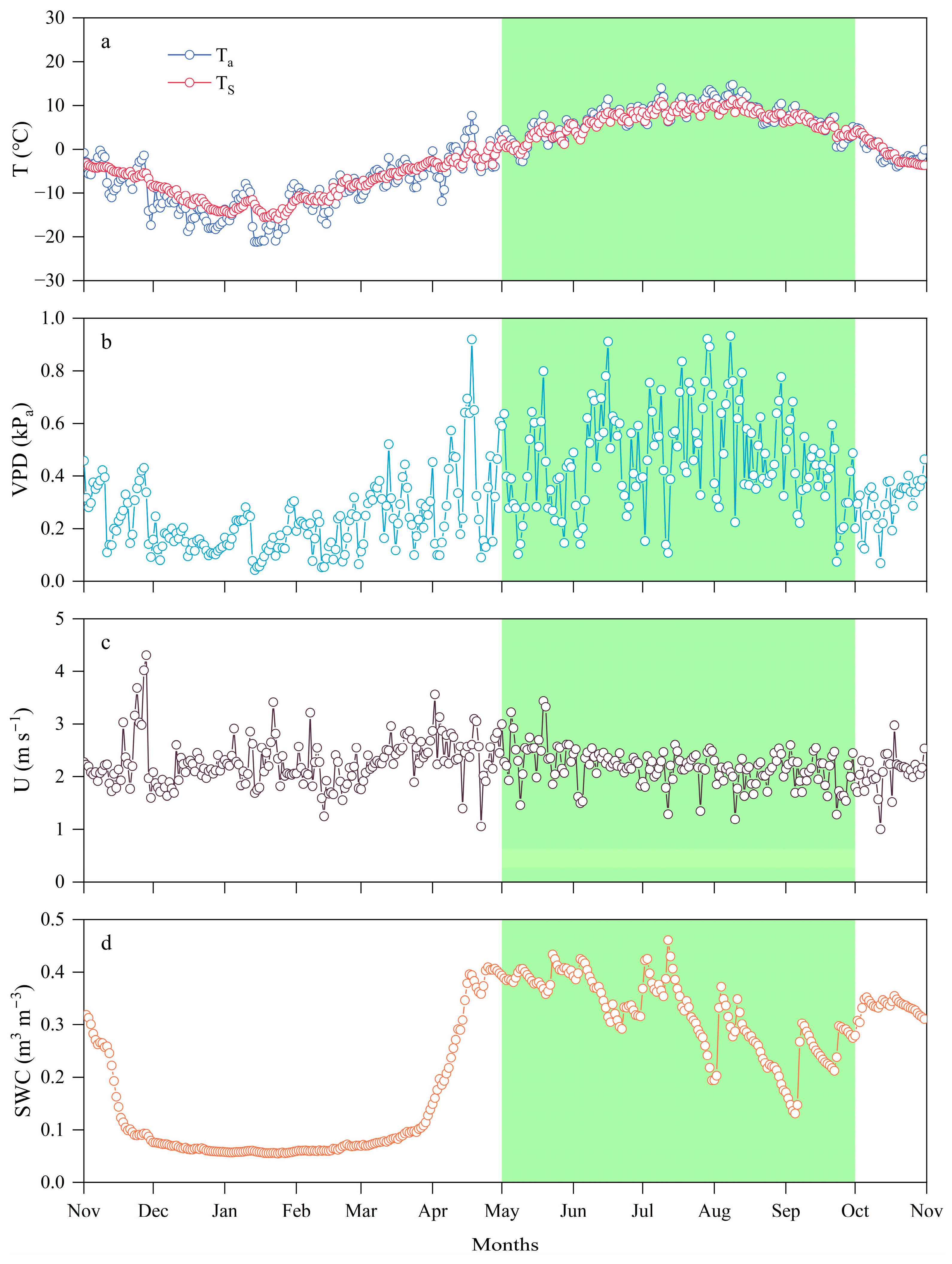
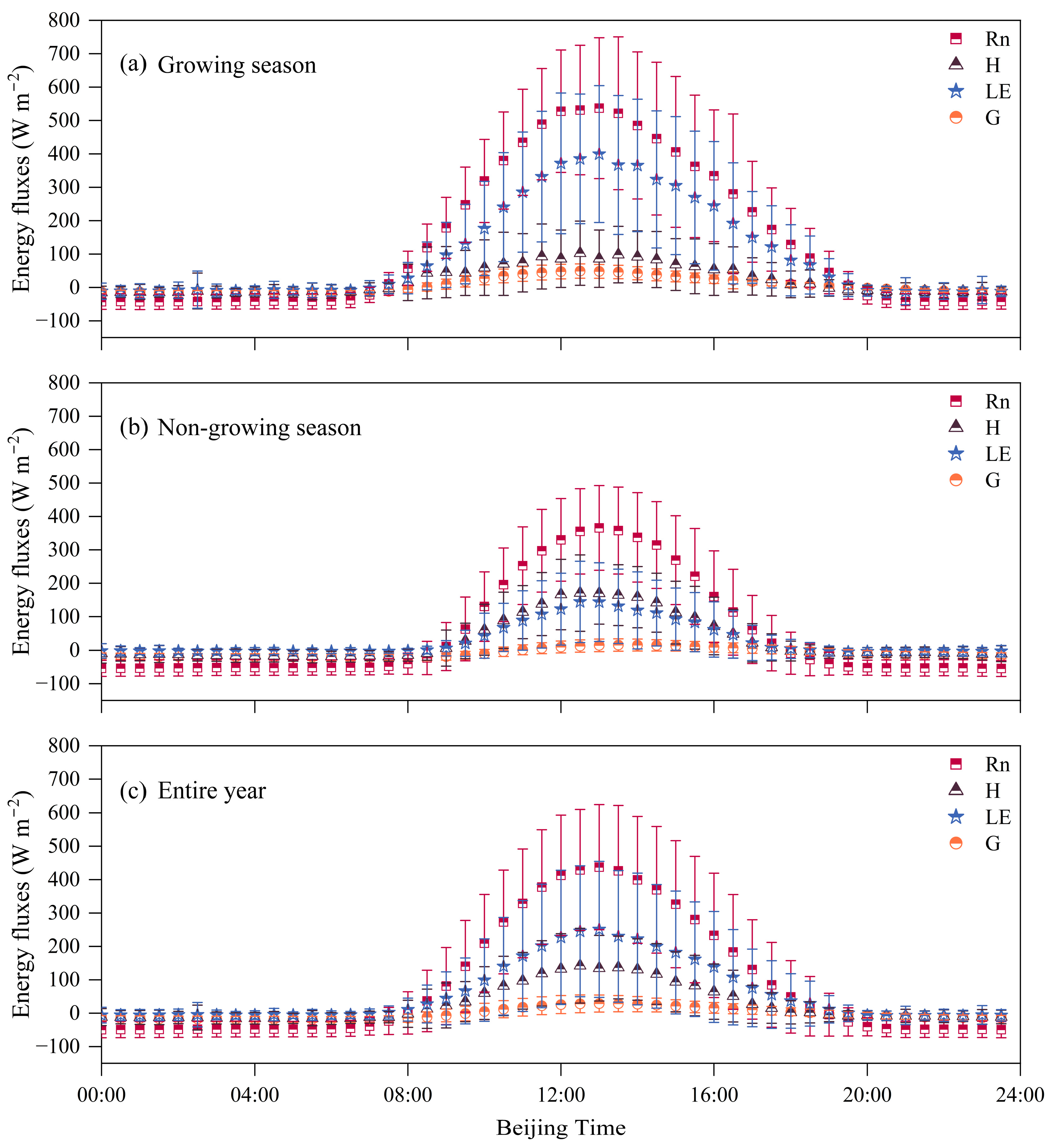
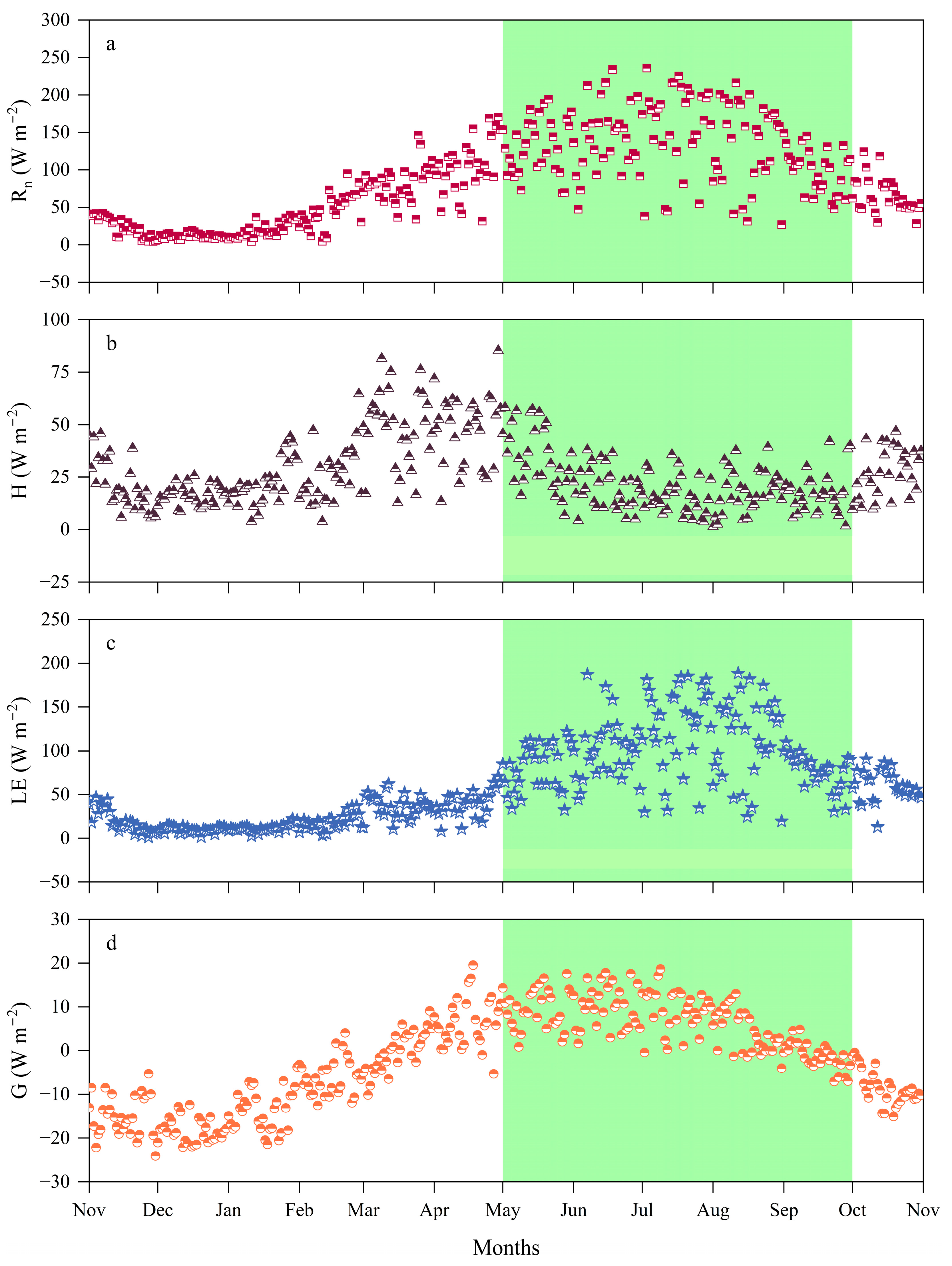
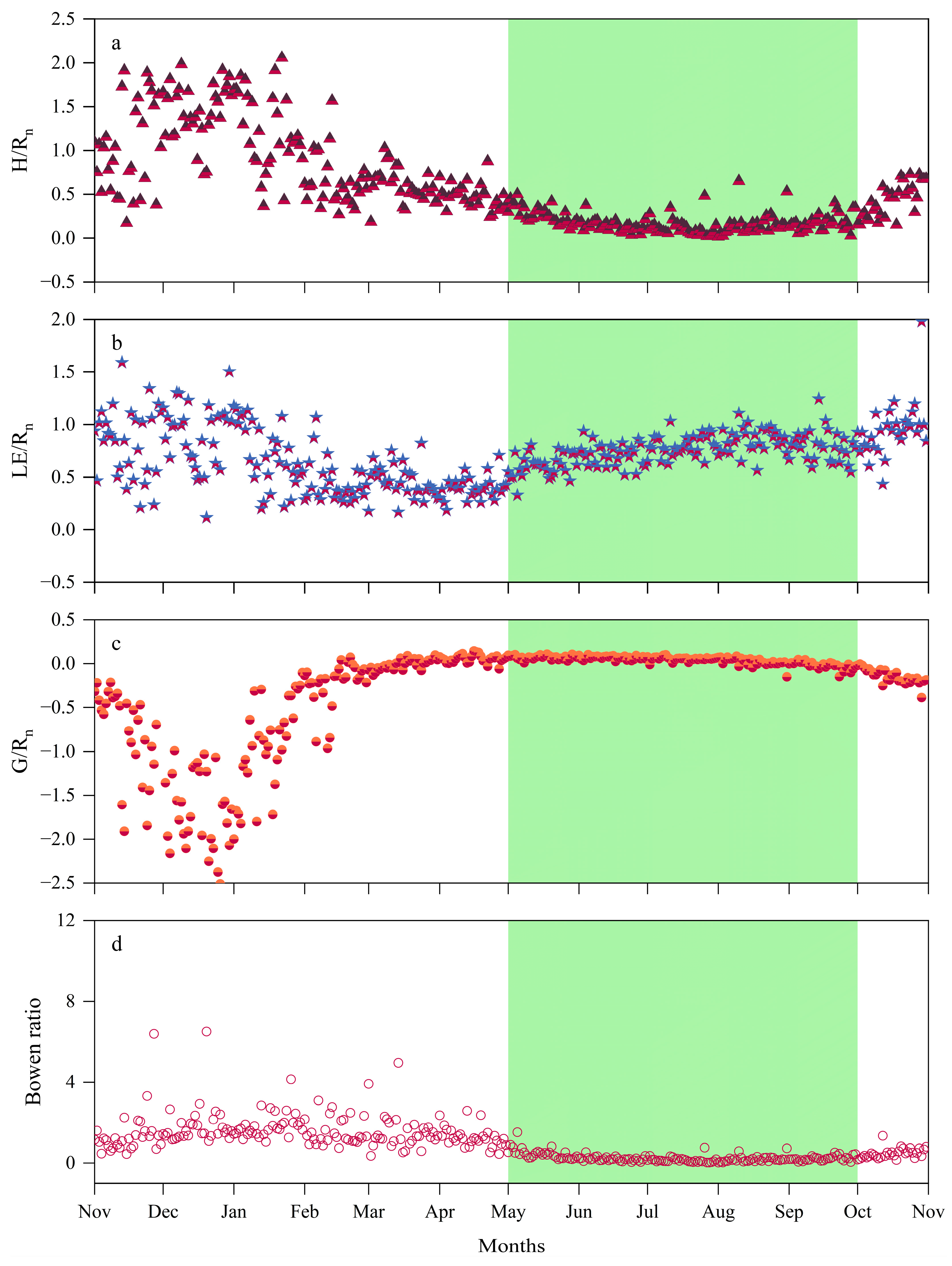
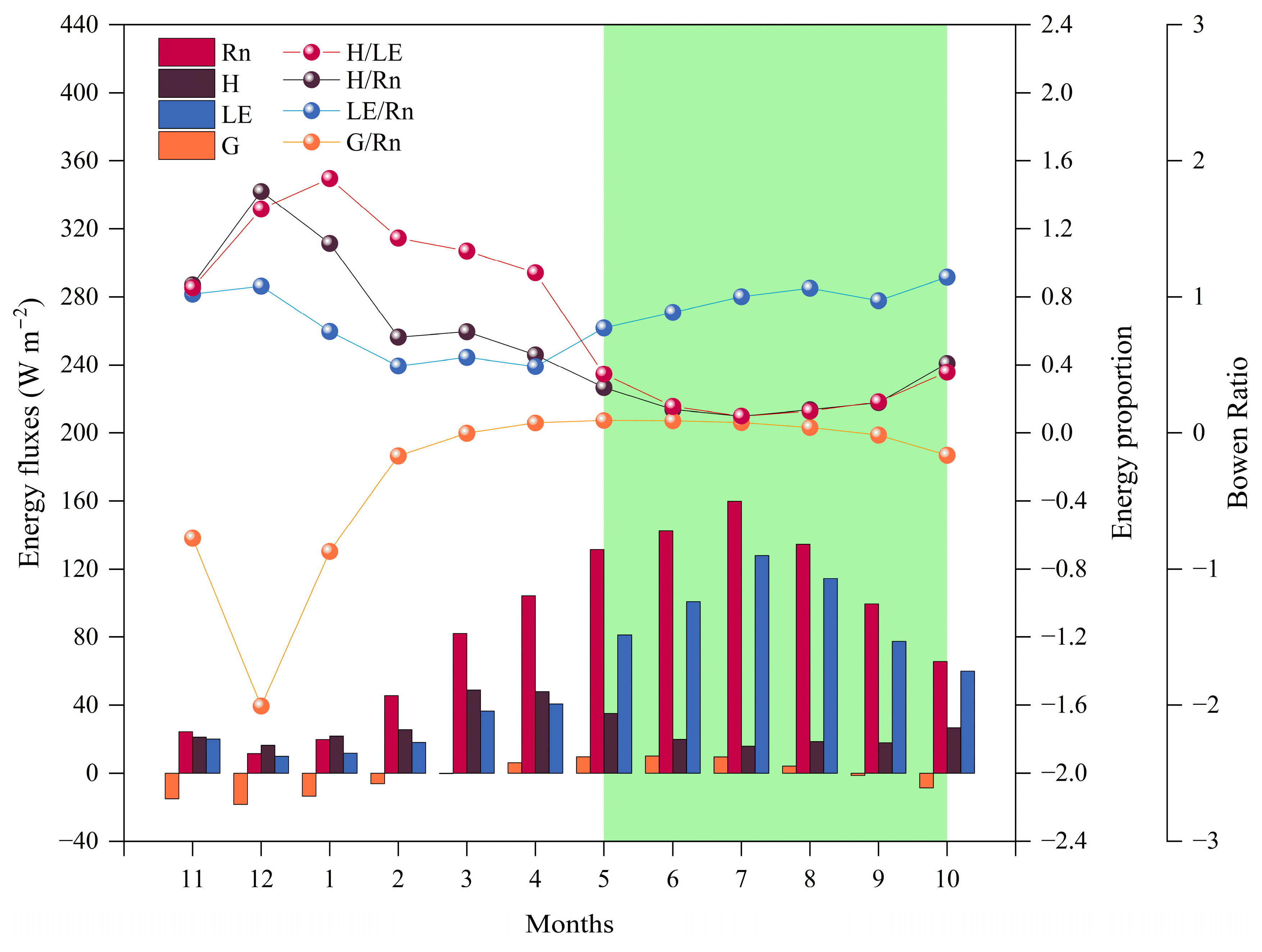
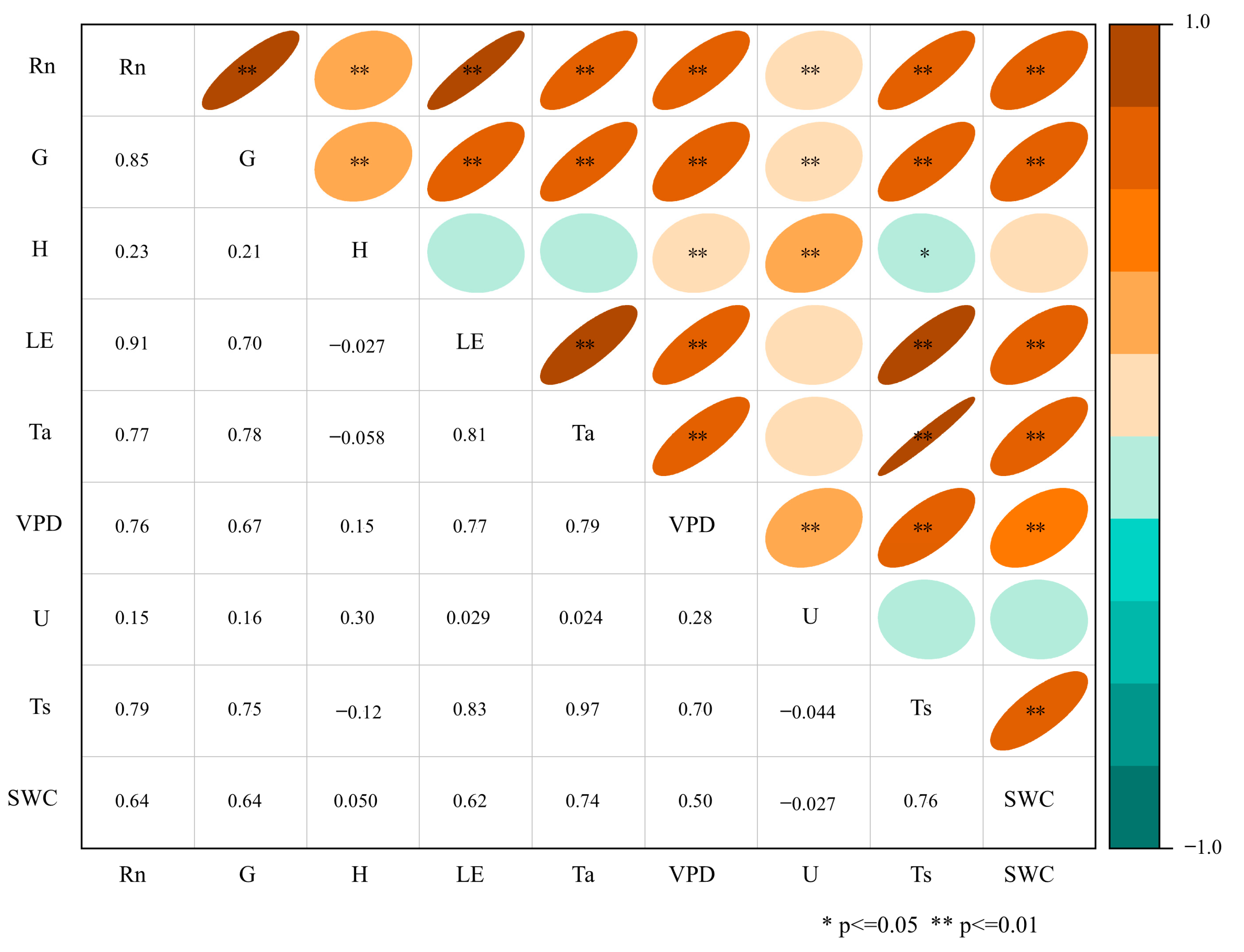
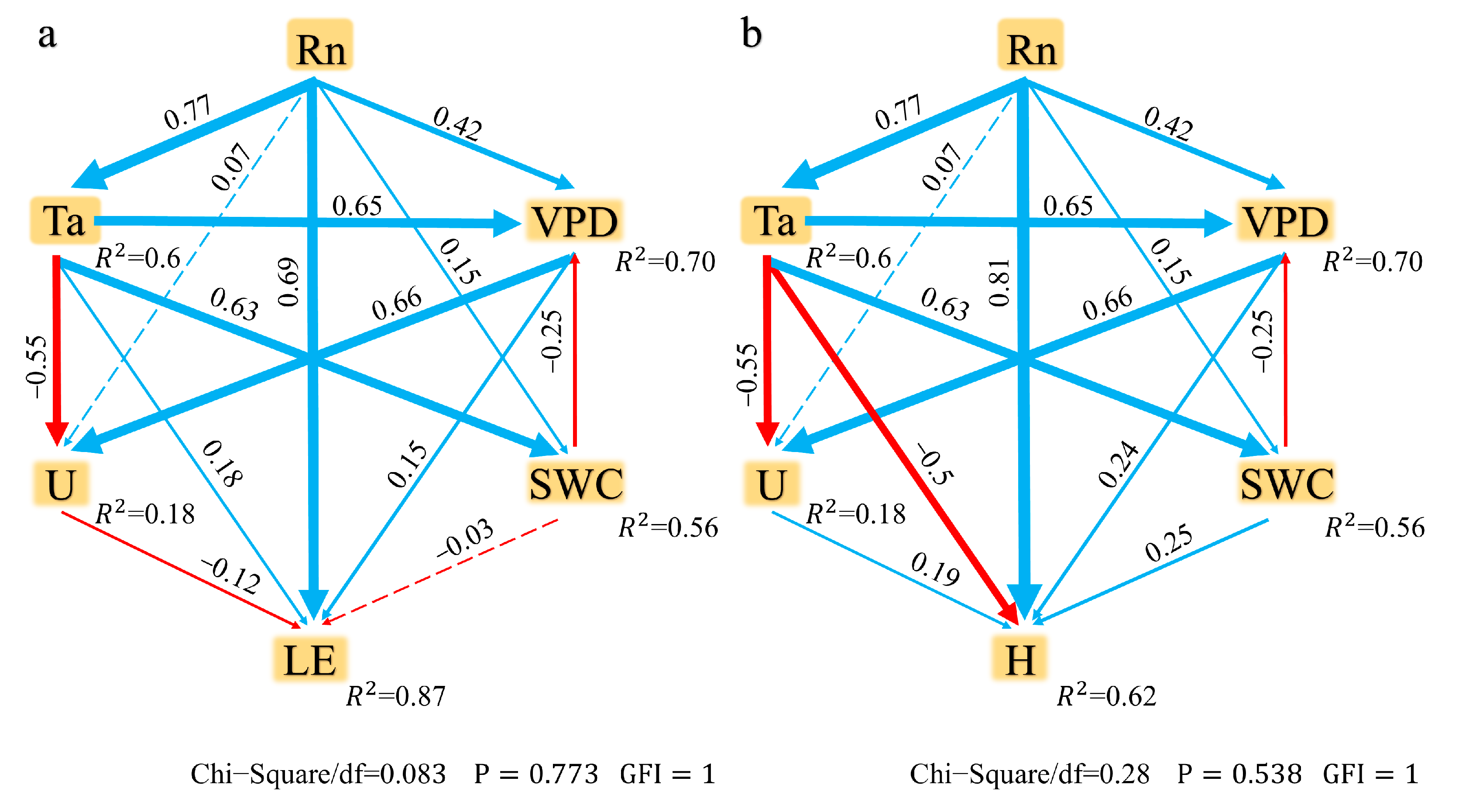
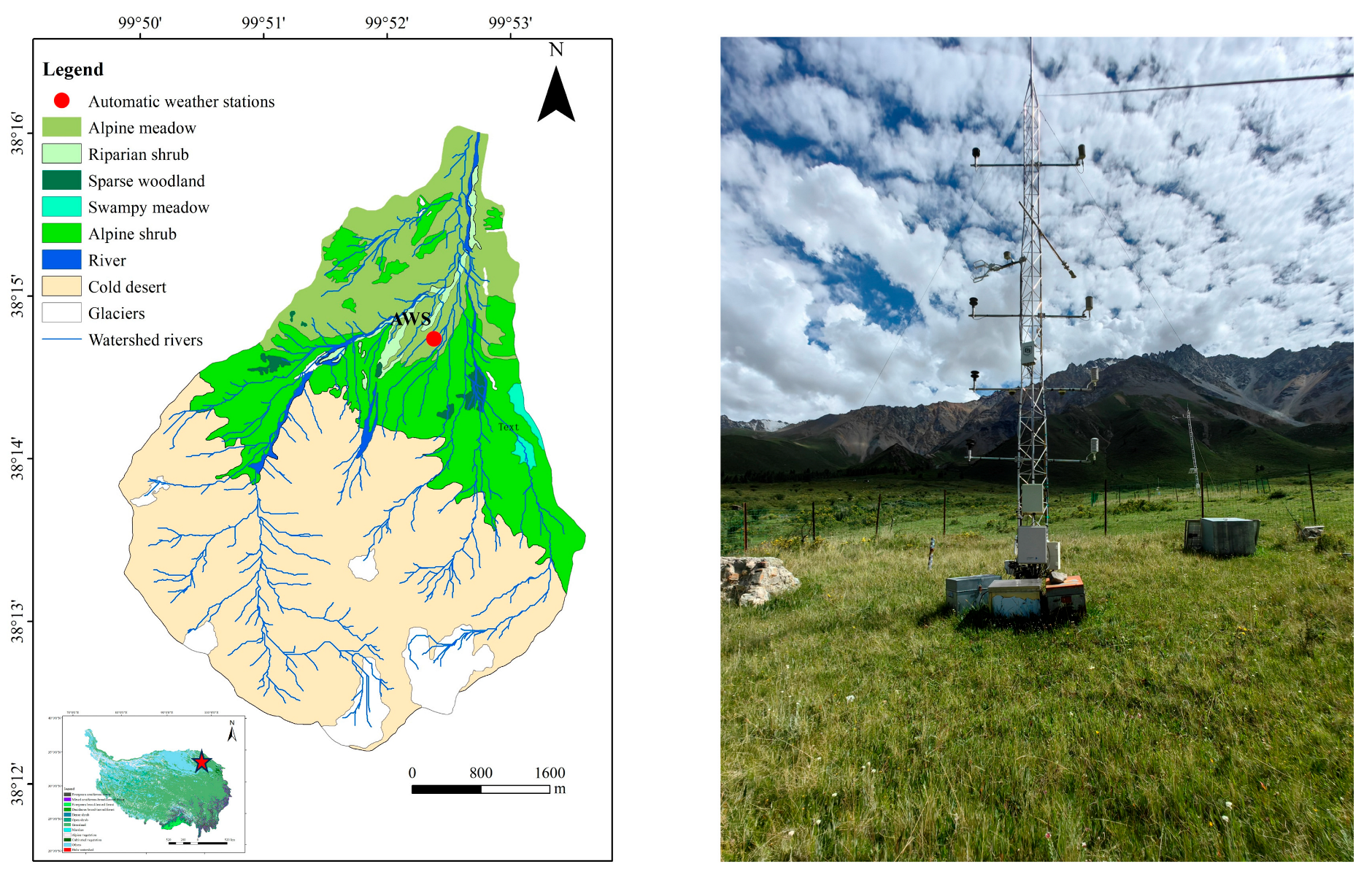
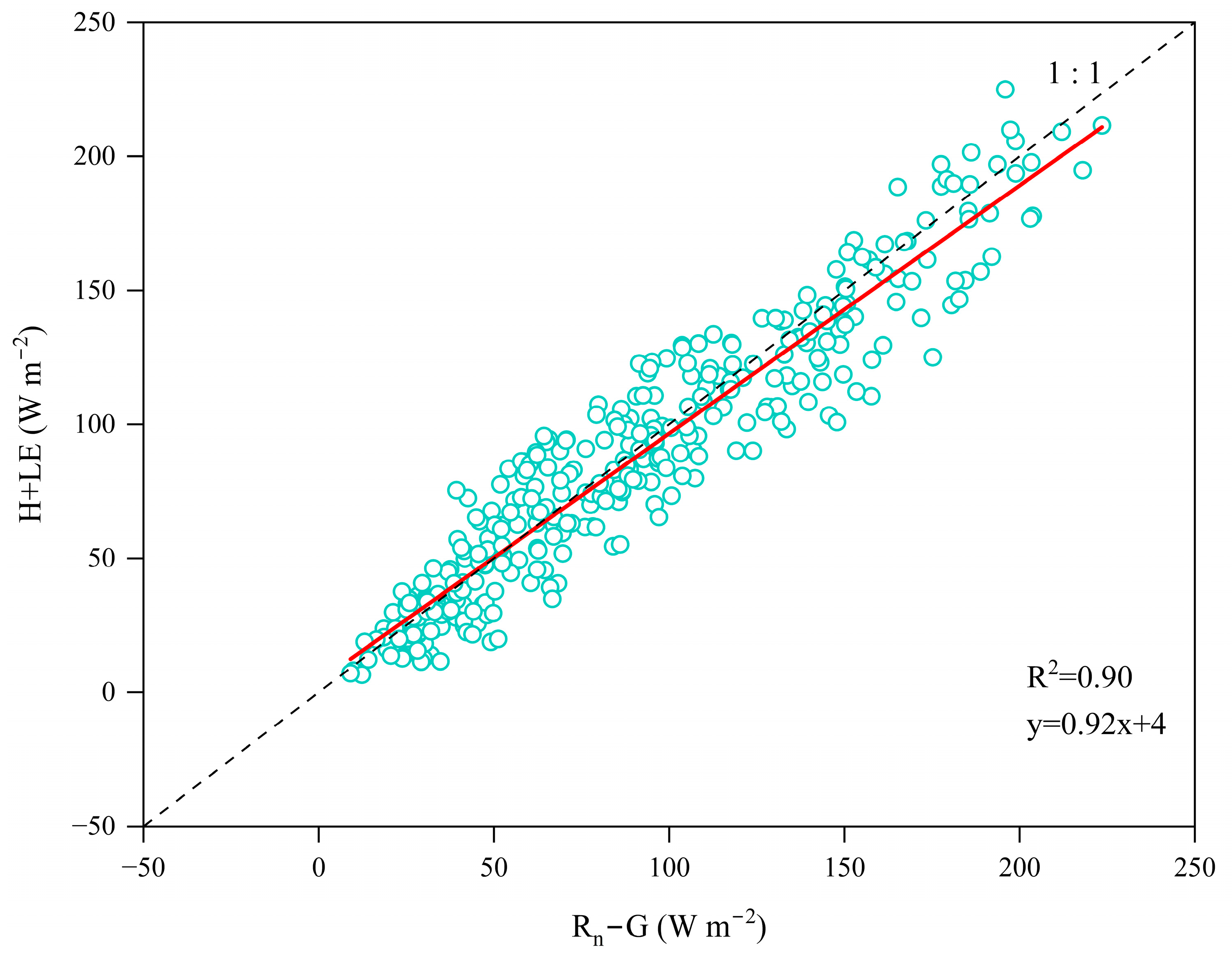
| Item | Growing Season (May–September) | Non-Growing Season (October–April) | Entire Year |
|---|---|---|---|
| Ta (°C) | 7.12 | −7.77 | −1.53 |
| Ts (°C) | 6.41 | −6.89 | −1.31 |
| VPD (kPa) | 0.47 | 0.24 | 0.33 |
| U (m s−1) | 2.19 | 2.24 | 2.22 |
| SWC (m3 m−3) | 0.32 | 0.16 | 0.23 |
| Rn (W m−2) | 133.70 | 50.35 | 85.29 |
| H (W m−2) | 21.36 | 29.79 | 26.25 |
| LE (W m−2) | 100.47 | 28.22 | 58.50 |
| G (W m−2) | 6.41 | −7.99 | −1.95 |
| H/Rn | 0.17 | 0.84 | 0.56 |
| LE/Rn | 0.75 | 0.67 | 0.71 |
| G/Rn | 0.04 | −0.57 | −0.32 |
| β | 0.25 | 1.42 | 0.93 |
| Variable | Sensor | Manufacturer | Accuracy | Height (m) |
|---|---|---|---|---|
| Net radiation (Rn) | CNR1 | Kipp & Zonen Kipp & Zonen (Delft, The Netherlands) | ±1% | 1.5 |
| Air temperature (Ta) | 41382VC; HMP 155A | R. M. Young (Traverse City, MI, USA); Vaisala (Helsinki, Finland) | ±0.05 and ±0.2 °C | 1.5, 7.7 |
| Relative humidity (RH) | 41382VC; HMP 155A | R. M. Young (Traverse City, MI, USA); Vaisala (Helsinki, Finland) | ±1 and ±2% | 1.5, 7.7 |
| Wind speed and direction (U) | Wind Sonic; Young05103 | Gill (Lymington, Hampshire, UK); R.M. Young (Traverse City, MI, USA) | ±0.01 and ±0.3 m·s−1 | 1.5, 7.7 |
| Surface temperature (Ts) | SI-111 | Apogee (Logan, UT, USA) | ±0.2 °C | 1.5 |
| Soil heat flux (G) | HFP01SC | Hukseflux(Delft, The Netherlands) | ±3% | −0.05 −0.20 |
| Soil water content (SWC) | Enviro SMART | Sentek (Adelaide, Australia) | ±0.1% | −0.05 −0.20 |
| Soil temperature (TS5, TS20) | 109SS-L | Campbell Scientific (Logan, UT, USA) | ±0.2 °C | −0.05 −0.20 |
| Rn | Net radiation, W m−2 | Kh | Heat exchange coefficient |
| Sd | Downward shortwave radiation, W m−2 | Kv | Water vapor exchange coefficient |
| Su | Upward shortwave radiation, W m−2 | T1 | Air temperature at Z1, K |
| Ld | Downward longwave radiation, W m−2 | T2 | Air temperature at Z2, K |
| Lu | Upward longwave radiation, W m−2 | e1 | Vapor pressure at Z1, kPa |
| G | Soil heat flux, W m−2 | e2 | Vapor pressure at Z2, kPa |
| Δz | Soil layer thickness, m | ρa | Mean air density at constant pressure, kg m−3 |
| Gp | Energy measured by the embedded soil heat flux plates, W m−2 | Cp | Specific heat capacity of air at constant pressure, J kg−1 K−1 |
| Cs | The volumetric heat capacity of the soil layer (J m−3 K−1) | τ | Adiabatic lapse rate, which is normally taken as 0.01 K m−1 |
| β | Bowen ratio | Δe | Vapor pressure difference between the lower and the upper measurement levels, kPa |
| ∂T/∂t | Rate of variation in the mean temperature of the soil layer | SWC | Soil water content at a depth of 5 cm, m3 m−3 |
| Ta | Air temperature at a height of 2 m above the ground, °C | VPD | Vapor pressure deficit, kPa |
| U | Wind speed at a height of 2 m above the ground, m s−1 | BREB | Bowen ratio energy balance |
| Ts | Soil temperature at a depth of 5 cm, °C | GS | Growing season |
| H | Sensible heat flux, W m−2 | NGS | Non-growing season |
| LE | Latent heat flux, W m−2 | δ1 | The absolute error limit of vapor pressure difference Δe |
| γ | Psychorometric constant, (kPa K−1) | δ2 | The absolute error limit of vapor pressure difference ΔT |
Disclaimer/Publisher’s Note: The statements, opinions and data contained in all publications are solely those of the individual author(s) and contributor(s) and not of MDPI and/or the editor(s). MDPI and/or the editor(s) disclaim responsibility for any injury to people or property resulting from any ideas, methods, instructions or products referred to in the content. |
© 2025 by the authors. Licensee MDPI, Basel, Switzerland. This article is an open access article distributed under the terms and conditions of the Creative Commons Attribution (CC BY) license (https://creativecommons.org/licenses/by/4.0/).
Share and Cite
Tian, Y.; Liu, Z.; Fan, Y.; Li, Y.; Tao, H.; Han, C.; Ao, X.; Chen, R. Patterns and Drivers of Surface Energy Flux in the Alpine Meadow Ecosystem in the Qilian Mountains, Northwest China. Plants 2025, 14, 155. https://doi.org/10.3390/plants14020155
Tian Y, Liu Z, Fan Y, Li Y, Tao H, Han C, Ao X, Chen R. Patterns and Drivers of Surface Energy Flux in the Alpine Meadow Ecosystem in the Qilian Mountains, Northwest China. Plants. 2025; 14(2):155. https://doi.org/10.3390/plants14020155
Chicago/Turabian StyleTian, Yongxin, Zhangwen Liu, Yanwei Fan, Yongyuan Li, Hu Tao, Chuntan Han, Xinmao Ao, and Rensheng Chen. 2025. "Patterns and Drivers of Surface Energy Flux in the Alpine Meadow Ecosystem in the Qilian Mountains, Northwest China" Plants 14, no. 2: 155. https://doi.org/10.3390/plants14020155
APA StyleTian, Y., Liu, Z., Fan, Y., Li, Y., Tao, H., Han, C., Ao, X., & Chen, R. (2025). Patterns and Drivers of Surface Energy Flux in the Alpine Meadow Ecosystem in the Qilian Mountains, Northwest China. Plants, 14(2), 155. https://doi.org/10.3390/plants14020155







